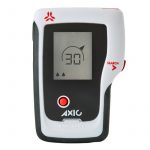Home » Gear Reviews » Ski & Snow » Avalanche Beacons » Pieps DSP
Pieps DSP Review
March 17, 2012
 83
83 The Good
- Long Range
- Accurate Distance readings
- Marking
- Multiple victim range
- Easy to use
The Bad
- Unreliable marking with analog beacons
- Slow response time in close
- The harness is weak
Overall the Pieps DSP Tour is a smart choice for the average backcountry skier. It's easy to use in single or multiple victim scenarios, can mark found victims, has excellent receive range, is software upgradeable, and is competitively priced. If you're more technically savvy, or a group leader the DSP may be worth a few extra bucks for all the bells and whistles this beacon offers.
Craig Dostie tested both the Pieps DSP and DSP Tour simultaneously, and filed one combined report.
The Pieps DSP or the DSP Tour are both solid beacons with the longest range of any digital beacon on the market. The DSP was the first 3-antenna beacon, which also made possible the ability to sense, find, and mark multiple victims. The interface for multiple users is simple and the range unparalleled. The DSP Tour does all that without a few non-essential, though nice, features for a hundred bucks less.
Distance
It doesn’t take long before you realize that Pieps is the long-range leader when it comes to modern avalanche beacons. In test after test, the Pieps DSP and Pieps Tour have the longest, most reliable receive range available (at least as of January 2012). Whatever the configuration, single, multiple, best or worst coupled, other beacons can only hope to equal the range of the DSP or DSP Tour beacons. Which is why the Pieps has garnered a loyal following because, even if it isn’t the only thing that matters, range does matter.
Switching modes
To switch to receive, press the locking tab on the right while pushing the on/off bar up until it is the search position. Once a signal is detected, the beacon shows you what direction to move via five directional arrows on the display, and a number indicating how many meters away it is. The directional arrows and distance readings of the DSP or Tour are noticeably more stable and less jittery than the Pulse or S1. In addition the number of signals within range will be shown at the bottom of the screen as horizontal bodies, up to a maximum of four (pray you never deal with that in a real situation).
Close searching
When you are closer than two meters the directional arrows no longer show up and you are advised to slow way, way down. The response of the Pieps lags a bit from the actual signal being sent out. Thus, if you are moving it quickly in the pinpoint phase of the search the distance reading you see may correspond to where it was positioned a half second earlier, not where it is when the display updates. Furthermore, my experience suggests it may take two pulses, or two updates in a row while in a static position for the distance number to settle out. How much it settles out depends on how fast you are moving the beacon. The slower you go, the faster it settles out, and the more precise it becomes.
When you have minimized the distance number, start probing. Once you have physically struck the victim, you can now mark it with the flag button. (You could do it earlier, but protocol demands you mark the victim physically too before marking electronically.) This allows the DSP or Tour to mask the signal you just found and focus on any other signals nearby, a feature that’s not found on the popular BCA Tracker 2.
As with other beacons capable of detecting and marking signals, older analog signals can give the DSP or Tour computational fits. In practice it means that the DSP may have a hard time ‘marking’ the beacon because the time stamp of the signal is distorted by spurious noise when you are close. When this is the case, the body icon at the bottom will blink, indicating you are close to an analog signal with lots of noise. You may have to repeat marking this victim a few times, or it may ‘unmark’ itself after being marked. The best cure is to back away a meter or so (after marking with a probe) before marking the signal so the noise from being too close is reduced.
Other notable features
There are two features in the DSP family that merit special mention. The first is called a smart transmitter. A hidden fourth antenna listens for other signals nearby when it is transmitting. If it senses that the timing of the pulses between itself and others will result in signal overlap (which can confuse searchers) it will adjust the timing of the pulse so it transmits when the others are off.
The second feature is iProbe support. If you’re lucky enough to be using an iProbe for pinpointing the exact location of a victim, the iProbe will give you an audible tone when it is within 50 cm (~ 2 ft.) of a victim’s beacon. If the buried beacon is a Pieps with iProbe support, as soon as the tip of the iProbe is within 50 cm, 30cm for good measure, it will turn the transmitter off on the buried beacon off so it no longer adds to the clutter of signals in a multiple victim search. If someone pulls the iProbe out, the beacon will begin transmitting again.
DSP Tour vs. DSP
The DSP has a few features the DSP Tour does not. One is the ability to do a series of scans to determine how many signals are within 5 meters, 20 meters, and 50 meters. This knowledge may help speed up a search for multiple victims if the rescue team is properly trained. Another feature is the option to search for Pieps TX-600, a transmitter for dogs that is offset 1000 Hz lower at 456.0 kHz if your pooch is beeping but managed to get caught and buried. The TX-600 won’t give a false signal for regular beacons to pick up, but can be found with the DSP.
Finally, the DSP can detect and display the actual frequency of companion beacons (smart trailhead protocol) to see if they are transmitting on frequency or not.
Poor harness
The only feature that fails to impress is the harness. On first look, it appears simple and easy to wear but the length adjustment of the shoulder sling never seems to hold position. Fortunately the beacon itself comes with an elastic lanyard so it is easy enough to stash in a pants pocket—just don’t forget to clip the lanyard to a belt loop.
Craig Dostie is a veteran ski industry writer who shares his 30 years experience climbing and skiing the mountains on EarnYourTurns.com.

















